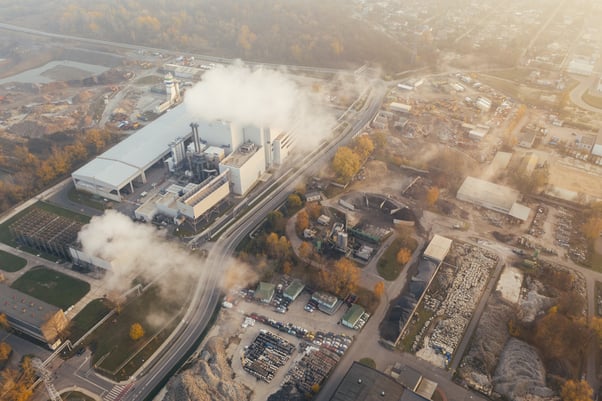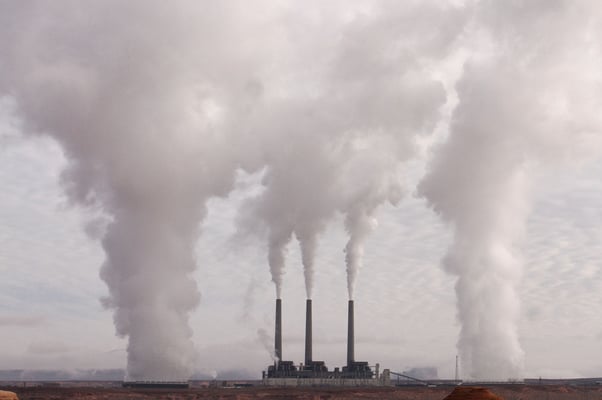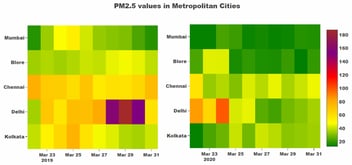All Air Pollution Terms You Need to Know Today!
Are you a Manufacturing/ Administration/ EHS/ Sustainability head? Are your commercial teams and facility managers looking for ways to address air pollution?
Let’s start here: by knowing terms/words related to pollution.
Being aware of air pollution will simplify the problem of controlling emissions at your premises. Here, it is said that pollution control is important. This article attempts to clear the fog around air pollution (pun intended) so you can understand better what exactly the problem is, and in what ways to address it.
Anthropogenic Emissions – Man made sources of air pollution/emissions. These include industrial, vehicular and other emissions arising from combustion.
Air Quality Index – An indication of current air quality levels.
Air Quality Monitor – An air monitoring device that provides data on the levels of different pollutants in the air.
Ambient Air – Refers to outdoor air.
CADR - Clean Air Delivery Rate is one measure of an air purifier’s efficiency. The CADR is relevant only at the highest fan speed for filter-based air purifiers.
POLLUTING EMISSIONS
Particulate Matter – Particulate Matter definition is Microscopic particles of dust pollutants. They can be composed of organic and inorganic components such as soot, metal, droplets, pollen, etc.

PM1 – Particulate matter that is less than 1 micron in size. They are extremely dangerous to human health. Inhaling PM1 can cause a variety of health hazards.
PM2.5 – Particulate matter that is less than 2.5 microns in size. PM2.5 particles are extremely dangerous to human health. Inhaling PM2.5 can cause a variety of health hazards.
PM10 – PM10 Pollution that is less than 10 microns in size. They are dangerous to human health.
Smog – Smog air pollution and the word smog stands for a combination of smoke and fog, typical of polluted cities in winter. Smog comprises different pollutants such as ozone, particulate matter and nitrogen oxides.
Ozone – A gas that is beneficial at the atmospheric layer, but a major pollutant at ground level.
Volatile Organic Compounds – Medical abbreviation; VOCs, they are a vast category of chemical vapors that are harmful to human health.
Nanoparticles - Pollutants that are nanoparticles are particles measured in nanometers (1000 nanometers makes 1 micron). Nanoparticles range from 1-100 nanometers in size. These particulate pollutants, owing to their small size, are suspended in ambient air much longer than larger particles and are more easily inhaled by humans. It therefore poses a more serious health risk.

Nanoparticles from vehicular emission impact heart and brain health in a detrimental way. Image Courtesy: University of Oxford
Greenhouse Gases – These are gases that trap heat within the atmosphere. An excessive amount of greenhouse gases contributes to global warming. The most common greenhouse gases include carbon dioxide, methane, nitrous oxide and fluorinated gases.
Fluorinated Gases – A category of anthropogenic emissions, these comprise gases such as hydrofluorocarbons, perfluorocarbons, and fluorides of nitrogen and sulphur.
Lead – Lead emissions are caused primarily by metal and ore processing activities, waste incinerators, etc. Lead concentration in the air can cause serious health problems, especially for children.
Fugitive Emissions – Fugitive Emissions refers to gaseous pollutants that leak or ‘escape,’ and are unaccounted for. Fugitive emissions are a major problem in different kinds of manufacturing plants.
Point-Source Emissions – Emissions from stationary sources. It is easy to trace the source of such emissions back to stacks, outlets, etc.
Point sources are single points of emission, such as stacks. Image Courtesy: Sciencing.com
Non-Point Source – A source of emission that is not easily identifiable. Leaks of particulate matter from transportation and loading, for example, are not identifiable and stationary sources.
TECHNOLOGIES & SOLUTIONS TO ADDRESS AIR POLLUTION
Filters – These are used by most air purifiers. Air is passed through a filter that collects pollutants. These are of different kinds such as HEPA, MERV, electrostatic, etc. Have different ratings according to the customer’s requirements. The HEPA filters used in operating theatres have a very high cleaning efficiency compared to those used in home air purifiers.
Filters require to be regularly cleaned/replaced in order for the air purification system to work effectively.
Smog Towers - These are “ anti smog towers” meant to address polluted zones such as cities. Each smog tower set up in Delhi cost Rs 20 crore. Each tower uses 5000 HEPA filters which need to be replaced every 3 months. The annual cost of maintenance is estimated at Rs 1.2 crore per tower.
Delhi’s first smog tower. Image Courtesy: NDTV
Anti-Smog Guns - These are among the most recent methods used to combat the smog in Delhi during the winter of 2021. These involve spraying mist into the atmosphere for a height of over 70-100 metres to clear away dust pollutants.
Baghouses – Also called baghouse filters, baghouses are voluminous structures used in industries to filter dust from the air.
Stacks - Chimney stacks help remove emissions from indoor plants and manufacturing units, and release them at a height into the atmosphere.
Scrubbers - These devices are used in industries to ‘scrub’ particulate matter from the air, by passing the air in contact with water droplets at high velocity. Venturi scrubbers are among the most commonly used types of scrubber.
Electrostatic Precipitators - ECPs, also known as dry scrubbers, use static electricity to separate soot and pollutants from emissions in industries. Ionizers, another type of pollution control device, work on a very similar principle.
Pulsed WiFi Air Cleaners - These devices use pulsed WiFi to increase the charge on particulate pollutants (PM) and accelerate their natural clearance. As yet, Pure Skies is the only solution based on this technology.
Ultraviolet Air Cleaners - These devices generate ultraviolet rays to rid indoor air of mould, fungus, mildew, bacteria, pollen, viruses, dust mites and other pathogens/allergens.
There are certain advantages to using pulsed WiFi technology, one of the most novel breakthrough technologies to addressing air pollution.
MITIGATION PLANS
NCAP – The National Clean Air Programme was formally launched in 2020. It aims to seriously address air quality in 122 Indian cities by reducing particulate matter by 20-30% by 2024 (with 2017 as the base year).
Non-Attainment Cities – These constitute a total number of 122 Indian cities identified by the NCAP as key cities to address for air pollution control by 2024.
Central Pollution Control Board - The CPCB was set up in 1974 as part of the Water and Air Acts that directly address pollution in India. The CPCB sets limits on the permissible levels of pollutants in the environment at a given point of time that industries are mandated to comply with.
Sustainable Development Goals (SDGs) - These are a set of 17 goals prescribed by the UN to be followed by governments, industries and businesses the world over. The SDGs are ultimately targeted towards the advancement of global health and wellbeing. At least 7 of the SDGs include addressing air pollution as part of their direct actionable agenda.
Air (Prevention and Control of Pollution) Act, 1981 - This act, passed by the Government of India, specifically addresses causes for air pollution in India. The air pollution act 1981 case study entrusted the CPCB with powers and functions.
INDUSTRIAL MEASURES TO CHECK AIR POLLUTION
ESG - Environmental, Social and Corporate Governance is a parameter of a company's mindfulness of social and environmental wellbeing as part of their efforts. Addressing pollution control is one of the primary ESG measures undertaken by companies. ESG efforts increasingly are increasingly favoured by stakeholders such as investors and customers.
Sustainability Reports - These report a company's ESG goals and its progress towards achieving those. Having air pollution control is one of the best ways for a company to enhance their sustainability report while avoiding regulatory fines.
We hope this article helped introduce you to the context of air pollution and the ways to deal with it. Air pollution is one of the most dangerous killers of our times, claiming 7 million deaths per year. Ensuring safe and healthy air entails protection from airborne diseases and greater immunity and resistance against ailments.
Air quality monitoring and large-scale, low-cost air pollution control is imperative if we want the present state of affairs to change.
Wondering how to tackle air pollution control in your industry?
Get a Free Consultation with our environmental experts by BOOKING A MEETING now!

.svg)
.webp?width=1080&height=1080&name=Free%20Case%20Study%20Steel%20Plant%20(1).webp)






Post Comments